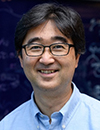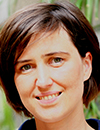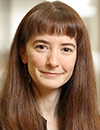Co-Located Conference AgendasCirculating Biomarkers and Extracellular Vesicles Europe 2024 | Lab-on-a-Chip and Microfluidics Europe 2024 | Organoids and Spheroids Europe 2024 | Point-of-Care, Biosensors and Rapid Dx Europe 2024 | 

Monday, 24 June 202407:30 | Conference Registration, Materials Pick-Up, Coffee and Networking in the Exhibit Hall | |
Conference Plenary Session Takes Place -- Please View Agenda for Plenary Session under the LOACEU2024 Track Agenda Tab |
| | |
Session Venue: Coolsingel Room |
| | 13:00 | Networking Buffet Lunch in the Exhibit Hall -- Network with Exhibitors and View Posters | |
Session Title: Advances in Organoid, Spheroid & Organ-on-a-Chip Research, circa 2024 |
| | |
Session Venue: Coolsingel Room |
| | 14:00 |  | Keynote Presentation Organoids with Reversed Biopolarity (ORBs): SARS-CoV-2 Drug Testing and Breast Cancer Progression
Shuichi Takayama, Professor, Georgia Research Alliance Eminent Scholar, and Price Gilbert, Jr. Chair in Regenerative Engineering and Medicine Wallace H. Coulter Department of Biomedical Engineering, Georgia Institute of Technology & Emory University School of Medicine, United States of America
This presentation will describe production of sub-millimeter diameter, consistent size and shape, lung, kidney, and mammary organoids that have an inverted, apical-out geometry. These Organoids with Reversed Biopolarity (ORBs) are used in 384 well plates in a single-organoid-per-well format to test drugs and disease physiology. The airway ORBs are infected with high yields with multiple SARS-CoV-2 strains with Omicron variant showing highest viral replication and Delta giving the most inflammatory response. The ORBs also predict anti-viral drug efficacy correctly where conventional 2D cultures give false signals. Early-stage breast cancer progression model studies will also be discussed. |
| 14:30 |  | Keynote Presentation CNS Organoid Models for Virus Research
Dasja Pajkrt, Professor of Viral Pediatric Infectious Diseases, Amsterdam University Medical Center, Head OrganoVIR Labs, Netherlands
Virus research historically relies on research using cell lines or animal models. Organoid technology is highly applicable in the virology field, yet unexplored. Organoid systems can mimic the in vivo human physiological environment and provide tools to study human host-virus interactions. The pathogenesis of a variety of human viruses, such as picornaviruses, HIV and human cytomegalovirus (CMV) is increasingly being studied using these novel human organoid models. Human airway epithelium (HAE) cultures and lung organoids allow for host-pathogen interaction studies on viral infections in the respiratory tract (RT), while human gut and brain organoids facilitate human gastro-intestinal tract (GIT) and brain studies. We established human RT (using HAE and lung organoids), GIT (using human gut organoids) and brain (using blood-brain- barrier, whole brain and forebrain organoids) 3D models to study virus infections such as SARS-CoV2, picornavirus, CMV and HIV infections. During the presentation I will share results that are derived from these studies. |
| 15:00 |  | Keynote Presentation Relevant 3D In vitro Models For Predictive Screening of Nanodrugs
Simona Mura, Full Professor, Université Paris-Saclay, France
Nanoscale systems for drug delivery have received considerable attention over the past decades, as they have the potential to overcome limits associated with conventional drug therapies, providing a solution to medical challenges that urgently require new therapeutic approaches. Nanodrugs can improve the therapeutic index of the loaded drug by providing protection against degradation, enabling controlled release and distribution, and increasing bioavailability. Advanced functionalization strategies have been used to confer them long-circulating properties and facilitate targeting to specific cells. These efforts have led to the introduction into clinical practice of a few nanoscale systems for tumor therapy. However, their small number, compared to the variety of promising systems proposed, reveals a considerable gap between favorable preclinical results and real clinical performance. Biological barriers, inherent to tumors and their microenvironments, pose formidable challenges. To bridge this gap, our focus turns to three-dimensional (3D) culture methodologies. Unlike conventional 2D cultures, 3D models better replicate the heterogeneity, pathophysiology, and structural architecture of real tumors. Our ongoing efforts involve constructing heterotypic multicellular 3D tumor spheroids, serving as robust screening tools. This approach aims to enhance our understanding of nanodrugs penetration and accumulation within the tumor mass. By identifying key parameters, we strive to maximize therapeutic benefits. In an upcoming talk, I will share the most significant results from our research in this evolving field. |
| 15:30 | Tumor Microenvironment 3D Cell Models to Address Therapeutic Response
Giacomo Domenici, Associate Scientist, Instituto de Biologia Experimental e Tecnológica (iBET), Portugal
The presentation will focus on the following topics:
- Representation of the Tumor microenvironment (TME) is critical to study response to advanced therapeutics.
- Different strategies to represent the TME, developed in the Lab will be presented, based on 3D cell culture models, namely:
- Reconstruction modeling strategies, involving cancer cell line derived spheroids and non-malignant TME cellular components co-cultures (e.g., fibroblasts, macrophages).
- Preservation modeling approaches employing patient-derived tumor tissue for translational and clinical research.
| 16:00 | Mid-Afternoon Coffee Break and Networking in the Exhibit Hall | 16:30 |  | Keynote Presentation Cancer-on-Chip Assay for Chemotherapy Sensitivity of Breast Cancer Tissue
Dik van Gent, Associate Professor, Erasmus Medical Center, Netherlands
Breast Cancer (BrC) response to chemotherapy is variable and biomarkers are not sufficient to correctly anticipate therapy response. Therefore, we aimed to develop an ex vivo assay to predict chemotherapy response in BrC patients, using a novel microfluidic platform. Patient-Derived Xenograft (PDX) tumors with known in vivo chemotherapy sensitivity or surgical BC samples were sliced and cultured in 6-wells plates (referred to as ex vivo culture), or in a Cancer-on-Chip (CoC) platform (BI/OND). Tissue slices were treated with the chemotherapeutic (e.g. cisplatin or paclitaxel) under both culture conditions. Tissue slices were Formalin-Fixed Paraffin-Embedded (FFPE) and 4 µm tissue sections were immunostained for proliferation, mitosis and/or apoptosis. Alternatively, a whole-mount immunostaining was performed to compare the 3D architecture of a fixed tissue slice with and without treatment. To observe cells over time a time-lapse experiment was done using Hoechst staining. The experimental setup allows assessment of the sensitivity of the PDX tumors by determining cellular proliferation, apoptosis and/or the ratio between mitotic and S-phase cells, depending on the chemotherapeutic used. The chemotherapeutics treatments yielded a better dose-response curve under the CoC culture conditions than the ex vivo method. Furthermore, CoC culture allowed longer incubation times without loss of viability (more than 14 days compared to 7 days). |
| 17:00 |  | Keynote Presentation Mesenchymal Stromal/Stem Cells Promote Intestinal Epithelium Regeneration After Chemotherapy-induced Damage
Magdalena Lorenowicz, Head of the Advanced In Vitro Model Systems Department, Biomedical Primate Research Center, Netherlands
Allogeneic hematopoietic stem cell transplantation (HSCT) is a curative treatment for leukemia and a range of non-malignant disorders. The success of the therapy is hampered by occurrence of acute graft-versus-host disease (aGvHD); an inflammatory response damaging recipient organs, with gut, liver, and skin being the most susceptible. Intestinal GvHD injury is often a life-threatening complication in patients unresponsive to steroid treatment. Secondline available therapies are immunosuppressants or mesenchymal stromal/stem cell (MSC) infusions. Data from our institution and others demonstrate rescue of approximately 40-50% of patients suffering from aGvHD with mesenchymal stromal/stem cells (MSCs) and minor side effects. Although promising, better understanding of MSC mode of action and patient response to MSC-based therapy is essential to improve this lifesaving treatment. Here, we developed a 3D co-culture model of human small intestinal organoids and MSCs, which allows to study the regenerative effects of MSCs on intestinal epithelium in a more physiologically relevant setting than existing in vitro systems. Using this model we mimicked chemotherapymediated damage of the intestinal epithelium. The treatment with busulfan, the chemotherapeutic commonly used as conditioning regiment before the HSCT, affected pathways regulating epithelial to mesenchymal transition (EMT), proliferation, and apoptosis in small intestinal organoids, as shown by transcriptomic and proteomic analysis. The coculture of busulfan-treated intestinal organoids with MSCs reversed the effects of busulfan on the transcriptome and proteome of intestinal epithelium, which we also confirmed by functional evaluation of proliferation and apoptosis. Collectively, we demonstrate that our in vitro coculture system is a new valuable tool to facilitate the investigation of the molecular mechanisms behind the therapeutic effects of MSCs on damaged intestinal epithelium. This could benefit further optimization of the use of MSCs in HSCT patients. |
| 17:30 |  | Keynote Presentation Joint on Chip Technology: A New Era in Studying Rheumatic Disorders
Marcel Karperien, Professor, University of Twente, Netherlands
Degenerative joint diseases such as osteoarthritis are a major and rising health care problem which cannot be effectively treated. Consequently there is a large unmet need for disease modifying treatments, with many attempts failed at phase 2 and 3 clinical trials due to lack of efficacy in recent years. This is in part due to the lack of translational power of frequently used animal models. To address this issue we have engineered the first prototypes of a cartilage-on-chip and a synovial membrane-on-chip which can be combined in a multi-organ on-chip device; the Joint-on-Chip (JoC) and have started the engineering of Hoffa’s fat pad- and ligament-on-chip. Our work on the cartilage-on-chip and the synovial membrane-on-chip is most advanced. Each of these chip models is complemented with mechanical actuation units enabling the controlled loading of the tissue. Loading regimes mimic the rolling motion of the moving joint. Indeed in our cartilage-on-chip model we showed that emulating the rolling motion of the joint resulted in the deposition of more cartilaginous matrix composed of glycosaminoglycans and collagen 2 and 6. It also induced the formation of a pericellular matrix. Matrix formation was much more abundant than in the devices exposed to compression only and to static culture in which there was virtually no matrix formation. This suggests that a combination of compression and shear stress such as uniquely seen during a rolling motion is beneficial for cartilage formation. In the synovial membrane-on-chip we were able to emulate the intima consisting of a cell layer of synoviocytes and macrophages. Challenging this intima with proinflammatory cytokines evoked a classical inflammatory response with increased mRNA expression of matrix degrading enzymes and pro-inflammatory cytokines and chemokines and upregulation of markers typically present in rheumatoid arthritis. In my presentation I will show a few examples how we are using these devices in drug screening to identify dearly needed new disease modifying treatments for degenerative joint diseases. In conclusion, we have successfully engineered models emulating key tissues of the articulating joint which will allow us to develop disease models for rheumatic diseases. In my presentation I will show a few examples how we are using these devices in drug screening to identify dearly needed new disease modifying treatments for degenerative joint diseases. |
| 18:00 |  Trends in Technologies and Markets for Lab-on-a-Chip & Organ-on-a-Chip Trends in Technologies and Markets for Lab-on-a-Chip & Organ-on-a-Chip
Claudia Gärtner, CEO, microfluidic ChipShop GmbH
| 18:30 | Networking Reception in the Exhibit Hall. French Wine Tasting Sponsored by Kloé. | 20:00 | Close of Networking Reception and Day 1 Conference Programming |
Tuesday, 25 June 202408:00 | Morning Coffee and Networking in the Exhibit Hall | |
Session Title: Technology Trends and Advances in Organoids, Spheroids, and Organs-on-a-Chip 2024 |
| | |
Session Venue: Conrad Room |
| | 08:30 |  Introducing a Cutting-Edge Industry Standard in Droplet Cell Biology Introducing a Cutting-Edge Industry Standard in Droplet Cell Biology
Natacha Coppieters, R&D Project Manager, LiveDrop SA
Despite the evident benefits of droplet bioassays over the past decades, the Life Sciences sector still lacks a robust solution for developing assays in microfluidic lab settings that seamlessly transition to industrial standards. LiveDrop has pioneered an integrated platform comprised of top-quality components and a user-friendly interface, bridging the gap between R&D and real-world applications that demand stringent standardization. ModaFlowTM establishes a new pinnacle for high-end benchtop standards, fulfilling the aspirations of every biology laboratory seeking excellence in single-cell and 3D cell culture droplet assays.
| 09:00 |  | Keynote Presentation Modeling Kidney Disease on a Glomerulus-on-a-Chip System
Stefano Da Sacco, Assistant Professor of Urology, GOFARR Laboratory for Organ Regenerative Research and Cell Therapeutics in Urology, Keck School of Medicine – University of Southern California, United States of America
Within the kidney, the glomerulus is the structure in charge of the renal ultrafiltration. Loss of glomerular function leads to renal damage and could end with irreversible damage. The major roadblocks to advancing new drugs and therapeutics designed specifically to preserve glomerular function stem from the inability to effectively develop multicellular in vitro models that can accurately mimic the architecture of the glomerular filtration barrier. We have developed a barrier-free, human-based glomerulus-on-a-chip system that closely replicates the glomerular filtration barrier and its functions. More importantly, we have shown that this system can be used for modeling various diseases including membranous nephropathy, Alport Syndrome, and diabetic nephropathy as well as be used as a novel tool for mechanistic studies, biomarker discovery, and personalized medicine. |
| 09:30 |  | Keynote Presentation Biofabrication of Tissue Assembloids
Yan Yan Shery Huang, Professor of BioEngineering, University of Cambridge, United Kingdom
Engineered assembly of multicellular materials, such as spheroids and organoids, represents a biomimetic process fundamental to tissue engineering and in vitro tissue modelling. Organization and fusion of different types of cellular building blocks can be harnessed to improve tissue maturation, and further, to achieve designable three-dimensional (3D) tissue architecture. Here, we illustrate diverse biofabrication strategies to create tissue ‘assembloids’. In the first example, a robust organoid engineering approach, Multi-Organoid Patterning and Fusion (MOrPF), is presented to assemble individual airway organoids of different sizes into upscaled, scaffold-free airway tubes with predefined shapes. Multi-Organoid Aggregates (MOAs) undergo accelerated fusion in a matrix-depleted, free-floating environment, possess a continuous lumen, and maintain prescribed shapes without an exogenous scaffold interface. By generating large, shape-controllable organ tubes, MOrPF enables upscaled organoid engineering towards integrated organoid devices and structurally complex organ tubes. In the second example, we demonstrate a deployable bioprinting strategy which can reconstruct compartmental tumoroids with cancer-associated fibroblasts (CAFs). The 3D printed core–shell tumoroids showed de novo synthesized extracellular matrices, and enhanced cellular proliferation compared to the tumour alone 3D printed spheroid culture. Further, the in vivo phenotypes of CAFs normally lost after conventional 2D co-culture re-emerged in the bioprinted model. Embedding the 3D printed tumoroids in an immune cell-laden collagen matrix permitted tracking of the interaction between immune cells and tumoroids, and subsequent simulated immunotherapy treatments. Overall, emerging development in biofabrication could significantly widen the applications of ‘assembloids’ for replicating cross-length scale tissue architectures towards in vitro models which integrate biology, physiology and anatomy. |
| 10:00 |  | Keynote Presentation Synthetic Substrates for Cellular Control
Mark Bradley, Professor of Therapeutic Innovation, Precision Healthcare University Research Institute, Queen Mary University of London, United Kingdom
The basis of my talk is polymer microarray technology which has been developed in the Bradley group for over 20 years. In my talk I will introduce polymer microarray technology and describe how this approach has been used in a large number of stem cell based applications – providing cells for a variety of screening applications - notably:
(i). The use of polymer microarray technology to discover a novel thermo-responsive chemically-defined hydrogel for long term culture of human embryonic stem cells and primary human mesenchymal adipose derived stem cells.
(ii). Polymer discovery that were able to support highly functional hESC-derived hepatocyte like cells (as active as primary human hepatoctyes) (with David Hay).
(iii). The development of polymers that bind cancer stem cells and stop their differentiation) (with Tetsuya Tega) (Stem Cells, 2016). |
| 10:30 | Mid-Morning Coffee Break and Networking in the Exhibit Hall | 11:00 |  Human Telomerized Cell Cultures to Establish Relevant and Standardizable Pre-Clinical in vitro Test Systems Human Telomerized Cell Cultures to Establish Relevant and Standardizable Pre-Clinical in vitro Test Systems
Regina Grillari, COO/CSO and Co-Founder, Evercyte GmbH
Organ-on-a-chip models mimic physiological conditions to study organ functions in vitro, with their effectiveness depending on cell source choice. Primary cells face challenges like donor variability and limited lifespan, while immortalized cell lines offer indefinite growth and stable characteristics, ideal for long-term studies. Evercyte's immortalized cell lines, resembling primary cells in function and morphology, have been integrated with microfluidic technology to create single and multi-organ chips. This integration replicates critical in vivo elements, providing a robust platform for preclinical research on cellular responses, toxicity, and biomarkers.
| 11:30 |  | Keynote Presentation Utilization of Spheroid Microarrays in Cell Line Shipment
Martin Frauenlob, Scientist, Cell Chip Group, TU-Vienna, Austria
The shipment of cells and cell lines is associated with high costs and heavy packages because of the amount of dry ice that cells need to be shipped on, to maintain their viability. Arrived in the laboratory, cells are stored in liquid nitrogen and afterward, upon use it still happens that a great number of cells are not culturable. To tackle this issue, we combined microarray technology with multicellular spheroid culture. There we found that due to the compaction in small multicellular spheroids, apoptosis is inhibited over a prolonged period. Further, multicellular spheroids bear already in vivo-like features such as spatial organization, cell-cell interactions, and deposited extracellular matrix, that improve model quality and reliability for drug testing. With this novel shipment technology, we try to improve and standardize cell-based research. |
| 12:00 |  | Keynote Presentation Models of Lymph Node Function in Top-Down and Bottom-Up Organs-on-Chip
Rebecca Pompano, Associate Professor, University of Virginia, United States of America
Predicting the response of the immune system to a new vaccine, a growing tumor, or neurodegenerative disease remains a grand challenge of biomedical science. Standard models of immunity rely largely on in vivo animal studies that are difficult to control and analyze over time, or simple in vitro cultures of human cells that lack the spatial organization and cell-cell interactions of the body. To enable controlled experiments with spatial structure, our laboratory creates spatially organized models of the lymph node and its connections to other organs. This presentation will describe recent work with two approaches. The first approach is “top down”, in which ex vivo slices of lymph node were used to model early responses to vaccination and tumor metastasis. In some cases, we integrated the lymph node slices into user-friendly microfluidic devices to provide environmental control and connectivity. The second approach is “bottom up,” in which primary human white blood cells were incorporated into a spatially structured organ-on-chip to model the interactions between T cells and B cells that lead to antibody production. We anticipate that these models of the lymph node are poised for future integration with additional organs and microphysiological systems, and for expansion to reflect the full diversity of the human population. |
| 12:30 | Networking Buffet Lunch -- Network with Exhibitors and View Posters | 15:30 | Best Poster Awards Sponsored by Lab-on-a-Chip Journal, Royal Society of Chemistry (RSC) -- In the Coolsingel Room |
|


 Add to Calendar ▼2024-06-24 00:00:002024-06-25 00:00:00Europe/LondonOrganoids and Spheroids Europe 2024Organoids and Spheroids Europe 2024 in Rotterdam, The NetherlandsRotterdam, The NetherlandsSELECTBIOenquiries@selectbiosciences.com
Add to Calendar ▼2024-06-24 00:00:002024-06-25 00:00:00Europe/LondonOrganoids and Spheroids Europe 2024Organoids and Spheroids Europe 2024 in Rotterdam, The NetherlandsRotterdam, The NetherlandsSELECTBIOenquiries@selectbiosciences.com